Canadian Theatre Encyclopedia
Kerr, Mary
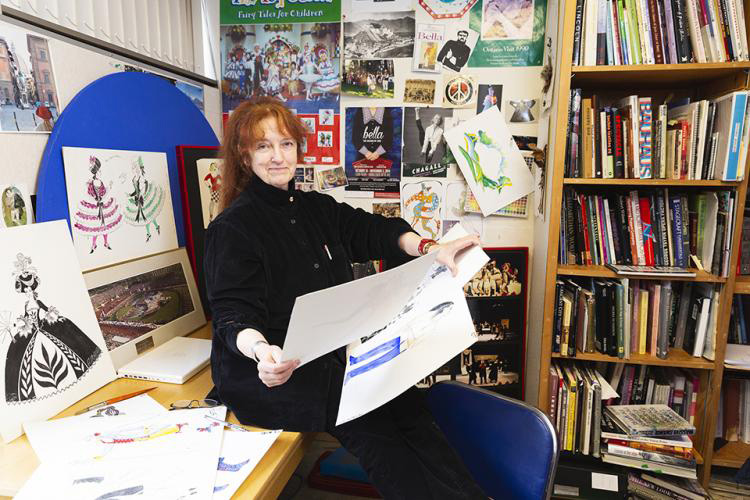
Dr. Mary Kerr, FRSC, RCA: Production Designer, professor, cultural commentator and equity pioneer for women designers in Canada. Her awarded national and international career includes theatre, dance, opera, musicals, feature film, television, university teaching, exhibition and opening ceremonies of special events. Her unique conceptual art has been described as kinetic sculpture on stage and is characterized by experimentation with architectural concepts, scale, unusual materials, colour, distortion, non-realism and often-satiric cultural commentary on the human condition. Colour, pattern, and rhythm are paramount in Kerr's costumes as well as for their humour, colour and fantasy.
Her multi-faceted practice has defined a truly original Canadian theatrical aesthetic. Her art has been chosen for four of the most notable international scenography books published in the last 15 years and included in numerous international design competitions. In 2019 Mary was chosen to be Canada’s ‘Design Legend’ at The Prague 2019 International Design Competition.
As of 2025, Kerr is the only theatre designer, (and one of the few women) to be awarded the Canada Council’s $50,000 Molson award and elected to membership as a Fellow of the Royal Society of Canada.
As Christopher Newton, the long-time artistic director of the Shaw Festival, explains, Kerr’s divergence from the subdued designers of the British school was an explosion onto the Canadian theatre scene “like a volley of fireworks. Her use of colour was something that no one had seen in the theatre in Canada up until that point.”
Kerr grew up backstage at the Playhouse theatre in Winnipeg and around her mother’s dance studio where she also taught dance and competition baton twirling to work her way through university. She graduated from the University of Manitoba with a BFA Hons in sculpture and literature and later pursued graduate work at the University of Toronto in the Medieval Centre where she studied with two of her great cultural and teaching influences: Marshall McLuhan and Northrop Frye. This uniquely Canadian training, along with her undergraduate thesis on the integration of Art in Architecture, helped develop her artistic and cultural sensibilities and led her to work in theatre.
Her friendship and collaboration with director-designer and fellow student, Stephen Katz was ‘transformative’ and basically transitioned her art practice from sculpture into theatre design. They collaborated on nine highly unusual productions in the 70’s (2 at the university,) "striking for their formalist aesthetic, brazen theatricality, conceptual intelligence, and satirical edge" (Kerr and Newton, 140). In 1972, she production designed their now iconic: The Stag King by Carlo Gozzi, adapted by Sheldon Rosen for the Tarragon Theatre, creating a miniature Renaissance court stage with a false proscenium and chequered floor from the bare bones interior of a former electronics factory that typically did Canadian realism. Eclectic costumes in exaggerated commedia and Ballets Russes styles were in bright allegorical colours for good, evil, and compromised characters. Together they went on to create for Vancouver Playhouse: Mandragola (1974) and The Caucasian Chalk Circle (1975); for the Shaw Festival: The Admiral Bashville (1974); and for Young People’s Theatre's Fresh Disasters by Larry Fineberg.
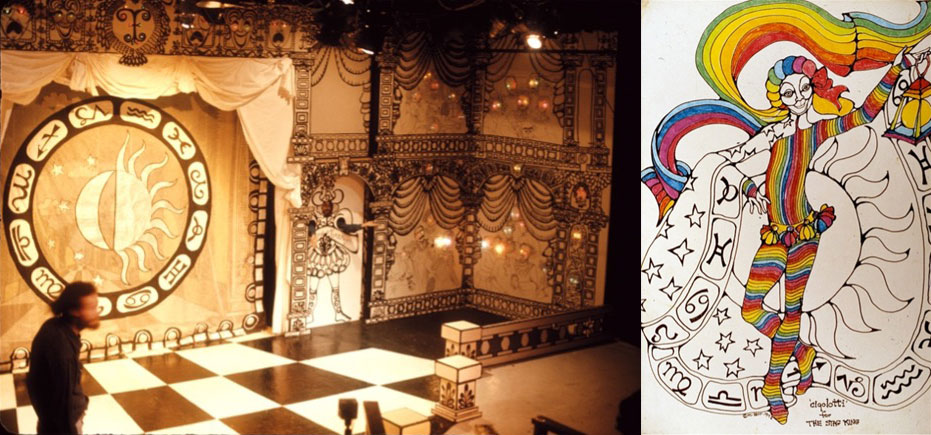
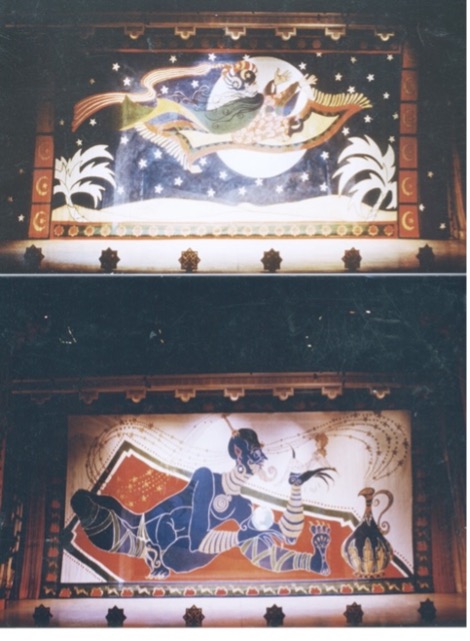
Kerr has designed over 300 productions for an eclectic range of theatrical disciplines across Canada, including: The Vancouver Playhouse (If We Are Women 1993); Toronto Free Theatre (Jungle in the Cities), Young People’s Theatre (Dreaming and Duelling, Buddies in Bad Times); Canadian Stage (George F. Walker’s Nothing Sacred 1988); Citadel Theatre (Into the Woods 2000, Sweeny Todd 2011); National Arts Centre (Marie Clements’s Copper Thunderbird 2007); Belfy Theatre (Jovette Marchessault's The Magnificent Voyage of Emily Carr 1992); Stratford Festival (Candide), and Shaw Festival (The Desert Song, Private Lives and Once in a Lifetime.).
For Nothing Sacred, she opened up the proscenium box with raked pine floorboards that flowed into the auditorium, suggesting perspective interiors with unframed doors on either side of the stage, and exteriors with cutouts of trees in unpainted layered wood.
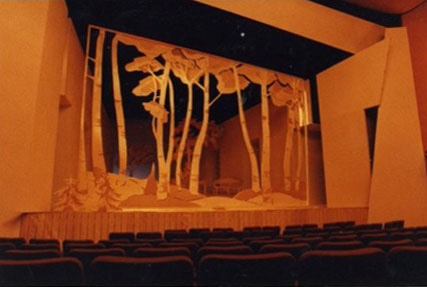
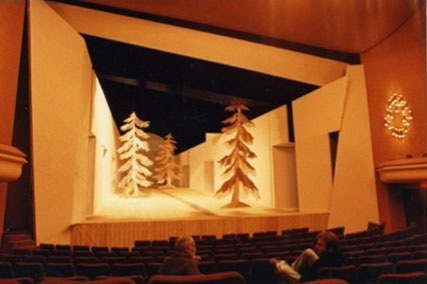
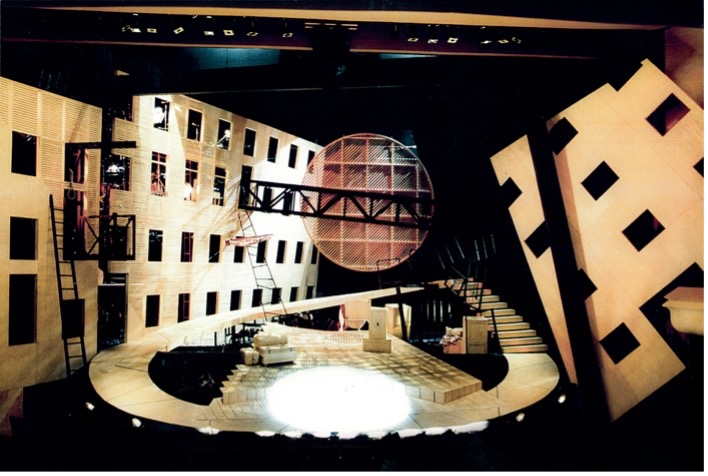
For If We Are Women, she created a wooden floor kitchen surrounded by a raked sea of silk, under luminous clouds and transparent fabric walls that responded to light to heighten the emotional connection among three generations of four women, and the seaside setting.
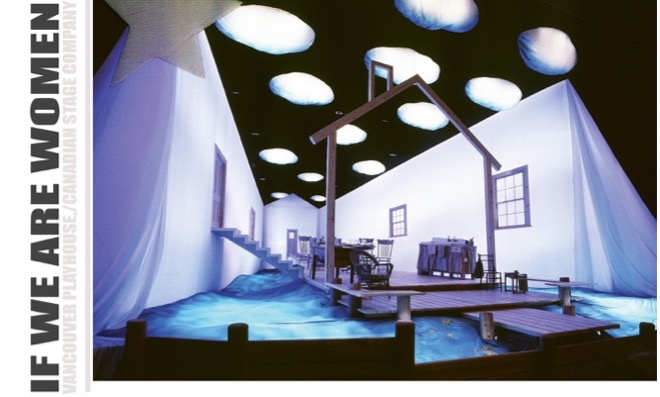
Indigenous collaborations include In the Land of the Spirits, the ballet produced through the Canadian Native Arts Society in the Opera of the National Arts Centre. Copper Thunderbird, at the National Arts Centre, the life story of the great Ojibway shaman painter Norval Morrisseau whose art and use of colour were major influences on Dr. Kerr’s practice.
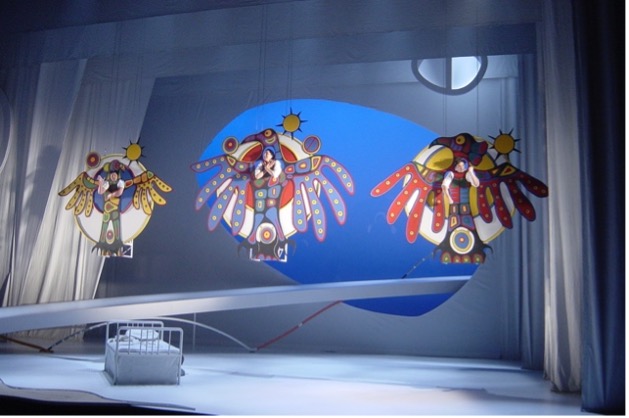
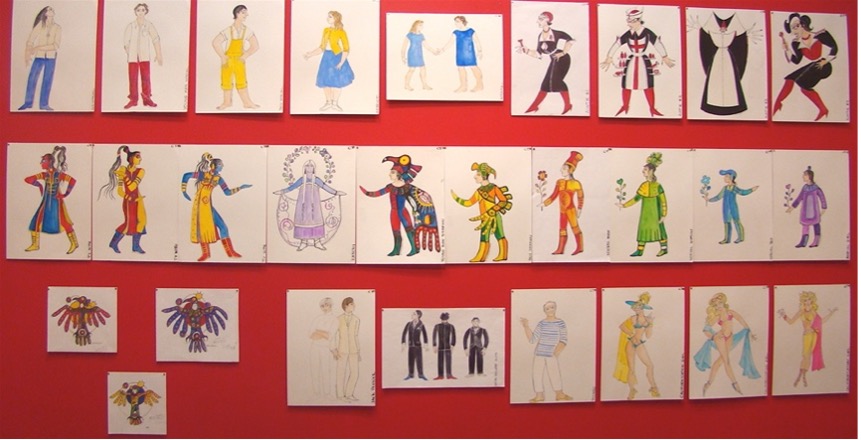
Dance and Musicals: Mary‘s extensive her dance and classical piano training has given her the confidence to interpret movement in unusual ways for: The Paris Opera Ballet, the Royal Winnipeg and National Ballet of Canada, Florida Ballet, Judy Jarvis, Entre Six, Anna Wyman and twenty-eight world premieres for the Danny Grossman Dance Company (1975 and 2000. Bob Fosee and Ming Cho Lee both commented that they had never seen such energy and gesture in costume sketches. She has designed productions for the Canadian, New Zealand, Vancouver and Pacific Operas Companies and Banff opera festival( Zurich 1916).
Television and Film: From 1977 to 1982, she designed the CBC’s Tommy Hunter weekly TV series for two years, as well as production designed National and International feature films. The award winning 3 season Toy Castle TV dance series for children (2001-2003) has been seen around the world.
Exhibition design: Kerr co-produced and production designed the first theatre of the Canadian Pavilion for Expo '86 in Vancouver.
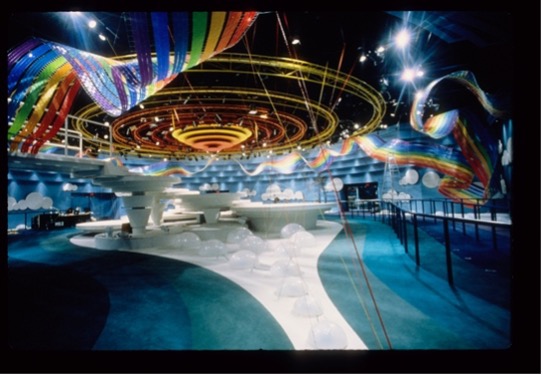
Opening Ceremonies: In 1994, as Production Designer for the Commonwealth Games in Victoria, she created the spectacular opening and closing ceremonies, in respectful collaboration with Chief Adam Dick, Clan Chief Kwaxistella of the Kwaxkwaka'wakw, and Kim Recalma Clutesi who ensured that the main section of the opening ceremonies gave vision to their oldest creation story: The Legend of Kawadillika. As a significant production element of the opening, Queen Elizabeth was convinced to leave the stands to greet Chief Adam in the Kwaxkwaka'wakw Big House created in the stadium. This ceremonial visualization of two equal chiefs meeting in peaceful celebration was an example to the world of Canada’s respect for the people upon whose land we all stand and sent a powerful symbolic message to the rest of the Commonwealth on a grand scale. The ceremony ended when a huge rainbow Dove of Peace transformed into a powerful Salish Thunderbird.
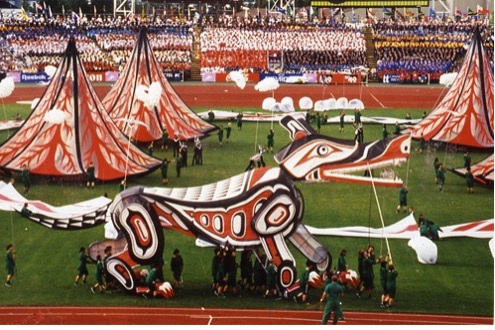
Awards: The hundreds of projects that comprise Mary Kerr’s more than forty-year career have been honoured with numerous theatre, film and television design awards including seven Dora Mavor Moore awards (fourteen nominations), three Sterling awards and numerous Gemini and Gemineaux nominations. Kerr has represented Canada four times at the prestigious Prague Quadrennial International Design Competition, as well as the USITT World Stage International Juried Stage Design Competition in 2005 and 2009.
In 2020, she was awarded the prestigious Molson Prize of $50,000, which honours contributions to Canada's cultural and intellectual heritage. Kerr was elected a Fellow of the Royal Society of Canada. Kerr is the only theatre designer so honoured for either of these distinctions. She is an elected member of the Royal Canadian Academy of Arts and was awarded a Doctor of Canon Law, honoris causa, by St. John’s College at the University of Manitoba.
Collections: Her work is the subject of the unique 5,000-piece Mary Kerr Collection at the Metro Toronto Reference Library and is represented in the archives of the Stratford and Shaw Festivals, The
University of Guelph as well as the Paris Opera Archival Museum.
While developing her design career, Mary has taught at Ryerson University, the University of Waterloo, York University, and the University of Victoria, where she was a design Professor in the Department of Theatre: 1998-2021. She is married to New Zealand architect, John Armitage.
website: marykerr.ca
Sources:
Mary Kerr and Alistair Newton. "Dreaming New Worlds: Katz and Kerr in the 1970s," Theatre Research in Canada 42.1 (2021).
Natalie Rewa. Scenography in Canada: Selected
Designers. Toronto: University of Toronto P, 2004.
Michael Kruse. The Title Block #58 (https://www.thetitleblock.com/episodes/2020/1/27/58-mary-kerr).
Metro Toronto Reference Library: The Mary Kerr Collection.
Last updated 2025-06-07

